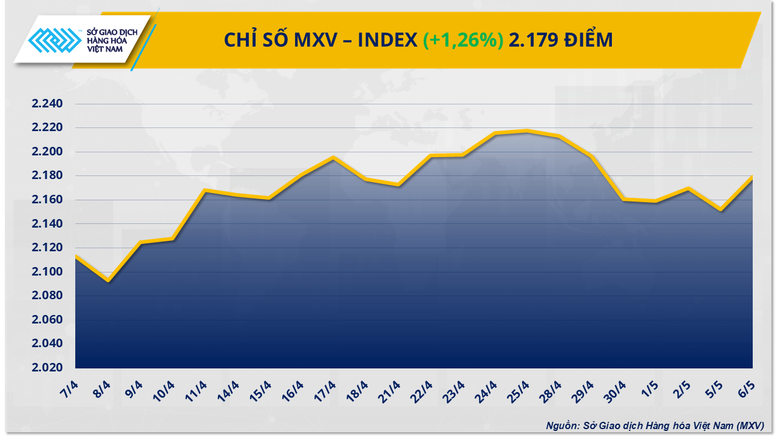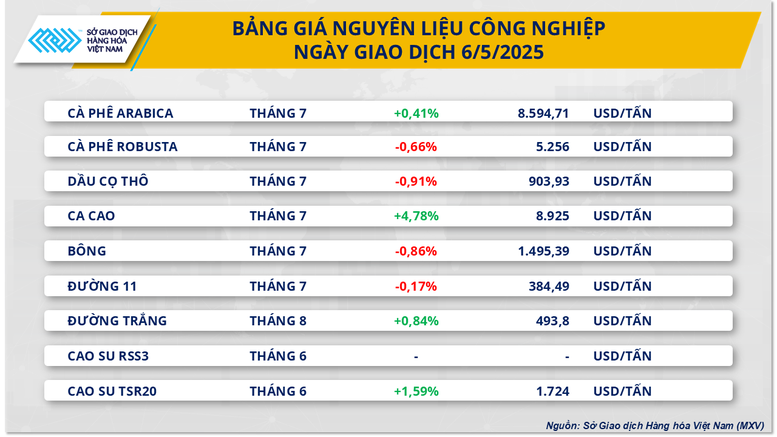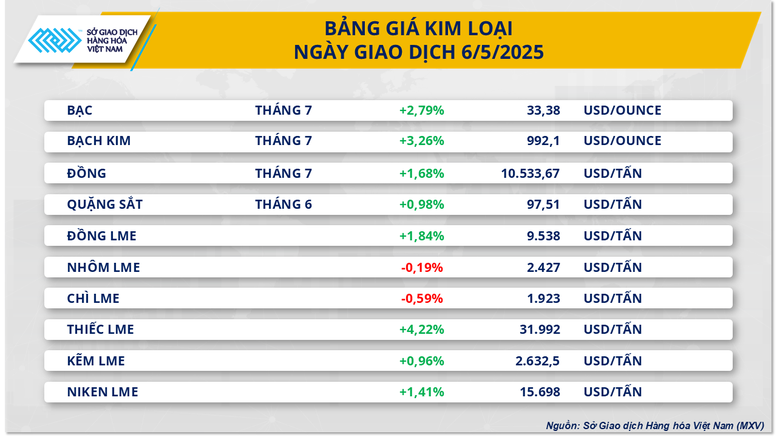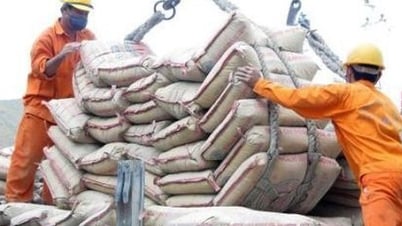
Cocoa prices return to $9,000/ton
According to MXV, cocoa stood out on the industrial raw material price list in yesterday's trading session. Closing, the price of this item jumped 4.78% to nearly 9,000 USD/ton, thanks to the weakening of the USD, which promoted short-covering activities in the futures market. The market was also affected by concerns about the mid-season harvest in Ivory Coast when late rains limited crop growth. According to Rabobank, this year's mid-season crop output in Ivory Coast is expected to reach only 400,000 tons, down 9% compared to the same period last year.
Meanwhile, the coffee market has seen mixed developments between the two commodities, as supply-demand and weather factors continue to have a strong impact on prices.

At the close of the session, the price of Arabica coffee for July contract increased by 0.41% to 8,595 USD/ton, while Robusta coffee decreased by 0.66% to 5,256 USD/ton.
According to Somar Meteorologia, Minas Gerais, Brazil’s largest Arabica growing region, received just 1.5 mm of rain in the week ending April 26, equivalent to 21% of the historical average and lower than expected. The dry weather in Brazil could affect the country’s coffee production in the coming season, thereby boosting buying in the market.
In addition, another factor that also contributed to the impact on coffee prices in yesterday's session came from Sumatra Island (Indonesia). Robusta coffee exports in March in this region reached more than 313,720 bags, a sharp increase of 476.8% over the same period last year, bringing the island's total Robusta exports in the 2024-2025 crop year to more than 1.6 million bags, up 80% over the same period last year. In addition, the USDA has just raised its forecast for coffee production in Guatemala - the world's 4th largest Arabica exporter - to 3.53 million bags for the 2024-2025 crop year, up 3.1% compared to the previous forecast.
The amount of certified wet-processed Arabica coffee stored on the New York Stock Exchange as of May 6 continued to increase by 6,252 60kg bags, bringing the total inventory of this item to over 838,380 bags. Of which, 776,750 bags are stored in Europe, accounting for 92.6% of the total inventory, and 7.4% is stored in the US.
In the domestic market, the price of green coffee beans in the Central Highlands on May 7 decreased slightly compared to yesterday, fluctuating between 127,500 - 128,100 VND/kg.

According to MXV, the metal market experienced positive developments yesterday when 8/10 items in this group increased in price, mainly due to increased demand for shelter and concerns about supply shortages in the market.
At the end of the session, silver price jumped 2.79% to 33.38 USD/ounce, while platinum reversed and recovered strongly 3.26%, reaching 992.1 USD/ounce.
Money flows into precious metals as demand for defensive assets increases amid global financial instability. In addition, the US trade deficit in March increased to $140.5 billion, far exceeding the previous month's $123.2 billion, mainly due to flat exports while imports increased sharply to $419 billion. This development reflects strong domestic demand but weak export momentum, raising concerns about the economic outlook and creating more momentum for safe-haven flows into precious metals.
In the base metals group, COMEX copper prices increased by 1.68% to $10,533/ton, amid the risk of a local supply shortage in the US as Canadian businesses - the second largest copper supplier to the US - began to withdraw from this market to seek opportunities in other regions. This trend raised concerns about the risk of narrowing copper supply in the US in the context of domestic production capacity not meeting demand.
Iron ore prices also rose 0.98% to $97.51 a tonne, thanks to positive consumption signals in China. According to the China Iron and Steel Association (CISA), as of April 30, the total inventory of five major finished steel products in 21 major cities reached 8.85 million tonnes, down 4.6% from April 20. Notably, inventories of wire rod and rebar – two products that closely reflect construction demand – fell sharply by 7.5% and 5.5%, respectively, indicating that actual consumption is showing clear signs of improvement.
Source: https://baochinhphu.vn/sac-xanh-quay-lai-thi-truong-hang-hoa-the-gioi-102250507084635969.htm






![[Photo] Prime Minister Pham Minh Chinh chairs conference to promote public investment growth momentum](https://vphoto.vietnam.vn/thumb/1200x675/vietnam/resource/IMAGE/2025/5/20/7d1fac1aef9d4002a09ee8fa7e0fc5c5)
























































































Comment (0)